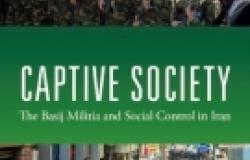Book Review: Captive Society: The Basij Militia and Social Control in Iran

Captive Society: The Basij Militia and Social Control in Iran by Saeid Golkar. New York / Chichester: Columbia University Press 2015. 289 pp, £41.50 hardcover 9780231704427, e-book 9780231801355
Iran’s Organization for the Mobilization of the Oppressed, commonly known as the Basij, is a paramilitary organization that was established shortly after the 1979 revolution to mobilize Iranian society and to defend the new regime against internal and external foes. Today, the Basij’s presence can be found in nearly all sectors of Iranian society including the economy, education and the public sector. Despite its importance to Iran’s power structure, existing studies on post-revolutionary Iran and its armed forces pay cursory attention to the Basij and mostly treat it as a mere paramilitary adjunct of Iran’s powerful Islamic Revolutionary Guard Corps (IRGC).
Saeid Golkar’s Captive Society fills a gap in the literature on Iran’s military by providing in-depth coverage of the Basij’s history, steady growth and increasing power since its inception. Central to the author’s analysis is the examination of the Basij’s role in sustaining the Islamic Republic of Iran’s regime through its control over Iranian society. The author achieves this, not only by highlighting its complex structure and multi-layered functions, but also by providing an insight into its increasing involvement and control over various societal sectors. As with some other works in the field of military studies, conducting fieldwork on Basij is almost impossible due to the sensitivity of the subject and the political situation in Iran. Nonetheless, the author has mitigated this problem by using a wealth of Persian sources, including IRGC and Basij publications, along with research on the Basij and online sources. Moreover, the author’s research is supplemented by the small survey that he has been able to conduct using 92 Basij members in order to assess their socio-economic backgrounds and their motivations for joining the organization. This, along with the author’s 13 individual interviews with Basij members in various bases in the city of Tehran and two smaller cities, provides a sound and evidenced-based methodology for the detailed study on the Basij that is presented in this book.
The book is structured into 5 parts and 14 chapters. Part I, Chapter 1 explores the need for a suitable analytical concept for understanding the Basij, and the notion of a paramilitary organisation or militia is proposed as the most suitable concept / category. While being similar to other militias in terms of its poor military training and its status as the armed subsidiary of the state, this chapter maintains that the Basij is one of the largest militias in “a fully functioning state” which is entrusted with a diverse set of economic, social, political and cultural tasks (p.9).
Part II deals with the Iranian state’s attempt to generate an insider’s network within the Basij and is composed of four chapters. Chapter 2 describes the development of the Basij in the course of the revolution and the Iran-Iraq war, with particular focus on its growing security, cultural and social functions during the Presidency of Rafsanjani and Khatami’s reform era (1997-2005), its peak after Ahmadinejad’s election to the presidency in 2005, and its transformation into a mass organization tasked with internal repression after the disputed re-election of Ahmadinejad in 2009 and the emergence of the popular uprising known as the green movement. Chapter 3 gives details of the hierarchical structure of the Basij and its chain of command and control, while Chapter 4 explains its different methods of recruitment from Iranian society. The compartmentalized structure of the ideological political training and indoctrination of Basij members is discussed in Chapter 5.
The Basij’s role in suppression and social control is discussed in Part III. This subject is examined within four sub-categories: the Basij’s role in transmitting propaganda among its members and rest of the society (Chapter 6); the Basij’s increasing role as a morality police and its promotion of Islamic principles (Chapter 7); the Basij’s role in surveillance (Chapter 8); and finally its increasing role in political repression (Chapter 9). This latter role came to the fore with the establishment of Basij Al-Zahra (for women) and Ashura battalions (for men) to counter the economic riots that erupted in various cities during the Rafsanjani era. The Basij role in political suppression grew further in response to Khatami’s reform era and activation of civil-society, and amplified during the Ahmadinejad era through the reorientation of the Basij military defence against both hard and soft threats. The Basij battalions were also expanded after the political uprising that followed the disputed presidential election in 2009.
Part IV examines Basij control over Iranian society with particular focus on families, schools, universities and the economy. Chapters 10, 11 and 12 show that Basij control over the aforementioned sectors was prompted by various political conflicts and tensions in post-Khomeini Iran and grew considerably after the Ahmadinejad presidency in 2005. Chapter 10 discusses the Basij’s controlling of families, showing the incorporation of women into its complex apparatus, which has increased steadily. Chapter 11 looks at the role of the Basij in controlling schools, and Chapter 12 presents an overview of the role of the Basij in controlling Iran’s universities. To this end, the author brings to the fore various channels of control in Iranian schools (Teachers Basij Organization and Student Basij Organization) and universities (The University Student Basij Organization and Teacher Basij Organization), together with sets of incentives and benefits allocated to the Basij students, such as admission quotas to universities. The confluence of these benefits and control channels is instrumental for mobilization of Basij members and its confrontation against various progressive students, teachers and professors. Chapter 13 explains the origin of the Basij involvement in the national economy, with particular focus on its expansion to nearly all sectors of the economy, including real estate and the stock market.
Part V of the book provides insights on the sociology of the Basij, its social composition and the motivation for joining it among its members. Using the available data on the Basij, as well as his survey and informal contacts, the author makes a number of informed observations. First, he substantiates the general view that the the social composition of the Basij is predominantly made up of lower socio-economic classes. He does this, through his own limited surveys of Basij respondents in Tehran. Of all his respondents, more than 55.4 percent stated that they are from the working class, 43.4 percent from the lower middle class, and 2.2 percent from upper middle class (p. 180). The author’s surveys also indicate that more than 95.6 percent of Basij respondents were from highly religious families (p.179). Second, the author discusses the motivations and reasons for joining the Basij based on the current statistics and his own surveys and interview, showing that the appeal of the Basij to most of its members has more to do with its privileges and benefits than ideological commitment. These incentives include admission quotas to universities, generous employment benefits and financial loans, and opportunities for upward mobility within the political system. Lastly, it is shown that with ideological and religious persuasion waning, the regime has sought to strengthen Basij loyalty through rigorous ideological indoctrination. Golkar suggests that the impact of this ideological training has been the radicalization of a small number of Basij members and by extension the alienation of the Basij from the sizable portion of the Iranian population.
This book is an important and commendable addition to the literature on Iranian politics, and will be of interest to anybody seeking a better understanding of Iranian and Middle East politics in general. The author deserves praise for his innovative method of examining the Basij and its role in Iranian society through the use of primary sources, and surveys, which adds to our knowledge of this under-researched organization. However, despite this, Golkar’s analysis of the Basij could have been more engaged with the empirical and theoretical literature on political militaries and paramilitaries. He attends to the theoretical literature rather briefly (in Chapter 1) and, as a result the unique nature of the Basij as a paramilitary organization remains further to be explored. This is particularly evident in the chapter on the economic role of the Basij (Chapter 13). In this regard, the author provides a rich empirical examination, while only briefly alluding to the rich literature on the economic role of military organizations in general. His account could have been more theoretically grounded in highlighting the nature and context of Basij business activities in comparison to its military counterparts.
Dr. Hesam Forozan received his doctorate from Durham University in 2014. He is the author of The Military in Post-Revolutionary Iran: The Evolution and Roles of the Revolutionary Guards, which was published by Routledge in October 2015.


